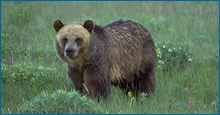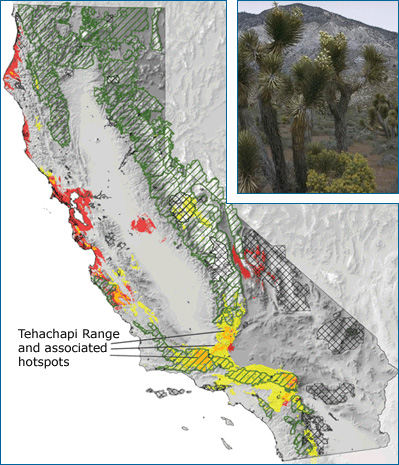
Wolves, grizzlies, and other endangered species dodged a bullet last month when the Department of the Interior briefly considered a new interpretation of the Endangered Species Act. The Act protects species that are at risk of going extinct throughout a significant portion of their range. This range has always included areas where the species historically lived (even if they’ve since been driven out). However, the interpretation proposed last month would have changed that, protecting a species only over the range in which it currently lives — a decision that could have made it more difficult for a dwindling species to make the list. Scientists responded by signing on to a letter protesting the decision and, in so doing, seem to have caught someone’s ear. On May 25, the Department announced that it would ditch the initiative. The Endangered Species Act exemplifies traditional conservation efforts to preserve historical diversity — but today, evolutionary theory is taking conservation in a whole new direction…
Where's the evolution?
 Imagine the diversity of life on Earth (crudely measured in numbers of species) as being represented by level of water in a bucket that has sprung a leak — just as the water level decreases with each drip, diversity decreases with each new extinction. Currently that bucket is leaking a steady stream of species as a result of human activities and habitat destruction. Most current conservation efforts (like the Endangered Species Act) aim to preserve diversity in the short term by stopping up that leak and lowering extinction rates. Those stopgap measures are essential, but they miss half the picture. Diversity can be maintained in two ways: by preventing extinction and by maintaining diversification — the rate at which new species evolve and drip into the bucket. New conservation efforts target this second element of diversity and aim to preserve not just evolutionary history (the species and environments of the past), but also evolutionary potential (the diversity that could evolve in the future).
Imagine the diversity of life on Earth (crudely measured in numbers of species) as being represented by level of water in a bucket that has sprung a leak — just as the water level decreases with each drip, diversity decreases with each new extinction. Currently that bucket is leaking a steady stream of species as a result of human activities and habitat destruction. Most current conservation efforts (like the Endangered Species Act) aim to preserve diversity in the short term by stopping up that leak and lowering extinction rates. Those stopgap measures are essential, but they miss half the picture. Diversity can be maintained in two ways: by preventing extinction and by maintaining diversification — the rate at which new species evolve and drip into the bucket. New conservation efforts target this second element of diversity and aim to preserve not just evolutionary history (the species and environments of the past), but also evolutionary potential (the diversity that could evolve in the future).
This approach might initially seem like wishful thinking. After all, how can we predict what species and habitats existing today are likely to play a key role in generating diversity tomorrow? In fact, evolutionary theory, like all other scientific theories, provides both a lens through which we can understand the past and a scope through which we might glimpse probable futures. Just as physical theories generate expectations about what sorts of bridges are likely to hold up in an earthquake, evolutionary theory generates expectations about what sorts of environments and situations are likely to contribute to diversification. Now, researchers from UC Berkeley and the California State Parks are teaming up to use this theory to pinpoint targets for conservation.
The project aims to identify conjunctions of landscape features that promote diversification and to ensure that these evolutionary “hotspots” (and the ongoing evolutionary processes taking place within them) are protected. Evolutionary theory and research suggest a few key features that are likely to encourage diversification — most particularly, spatial heterogeneity. A spatially heterogeneous area is one in which different traits are favored in different regions. To see how this could contribute to diversification, imagine a swath of land with abrupt changes in elevation, so that a forest abuts a grassland. A population of mice lives in the area, some in the forest and some in the grassland. Because of their different habitats, natural selection favors different traits in the mouse sub-populations. Darker coats, for example, might be advantageous for the forest-dwelling mice, while grassland-dwelling mice with lighter coats might have a better chance at survival. Over time, as natural selection favors distinct adaptations in different subpopulations, this single ancestral species could diversify into two distinct daughter lineages. And that is just one example. Many different aspects of spatial heterogeneity (soil conditions, microclimates, other species living in the different areas, etc.) could contribute to this sort of divergent selection, eventually leading to speciation — and to a fresh trickle of species for Earth’s standing pool of diversity.
Thus far, the project has identified several areas in California that meet the hotspot criteria. They exhibit features that we expect to encourage diversification, and research suggests that they house an unusual density of recently evolved lineages endemic to California (at least in terms of mammalian lineages). For example, the Tehachapi Mountains (located just northwest of Los Angeles) seem to be an important target for conservation. They sit at the crossroads of several major mountain ranges, the Central Valley, and the deserts of Southern California and harbor many recently evolved lineages, including the Tehachapi white-eared pocket mouse.

Such evolutionary approaches to conservation may not be widespread, but they do seem to be on the rise — and for good reason. Evolutionary theory gives us the tools to think ahead — to plan our conservation strategies around both life’s history and its trajectory. Life evolves, and if we want to protect the diversity of life on Earth for the generations to come, we must take that evolution into consideration.
Primary literature:
- Davis, E. B., Koo, M. S., Conroy, C., Patton, J. L, and Moritz, C. (2008). The California Hotspots Project: Identifying regions of rapid diversification of mammals. Molecular Ecology 17(1):120-138. Read it »
News articles:
- A brief on the possible reinterpretation of the Endangered Species Act from the Examiner
- The Hotspots Project website from the UC Berkeley Museum of Vertebrate Zoology
- A report on the conservation significance of an area in the Tehachapi Mountains prepared by the Conservation Biology Institute
Understanding Evolution resources:
- A tutorial on the process of speciation
- A 2006 news brief on the evolutionary basis of diversity
- A reader on other applications of evolutionary theory for conservation
Background information from Understanding Global Change:
- What two evolutionary processes described in this article directly affect the diversity of life (i.e., number of species) on Earth? How do those processes affect diversity?
- This article describes efforts to conserve “evolutionary potential” in California. Explain what “evolutionary potential” means in this context.
- What is a spatially heterogeneous environment? How does it contribute to diversification?
- This article describes one way in which evolutionary theory generates expectations about future processes and outcomes — in this case, regarding the identification of areas that are likely to generate diversity in the future. Research and describe another example in which evolutionary theory allows us to generate expectations of practical value.
- Research an example of a conservation effort not mentioned in this article that focuses on reducing extinction rates. Describe how that effort works to preserve diversity.
- Do you think that it’s important to conserve evolutionary potential? Why or why not?
- Teach about speciation and divergent selection: In this lesson for grades 6-12, students learn about variation, reproductive isolation, natural selection, and adaptation through a version of the bird beak activity.
- Teach about speciation in California: In this lesson for grades 9-12, students compare different subspecies of a California salamander on a grid map of California to focus on patterns of their distribution, their likely evolutionary relationships, and probable sequence of formation from the ancestral salamander.
- Davis, E. B., Koo, M. S., Conroy, C., Patton, J. L, and Moritz, C. (2008). The California Hotspots Project: Identifying regions of rapid diversification of mammals. Molecular Ecology 17(1):120-138.
- Flesher, J. (2007, May 1). Scientists protest new interpretation of Endangered Species Act. Examiner. Retrieved May 25, 2007 from Examiner.com
- Hebert, H. J. (2007, May 25). Government scraps species law changes. ABC News. Retrieved May 25, 2007 from ABC News
